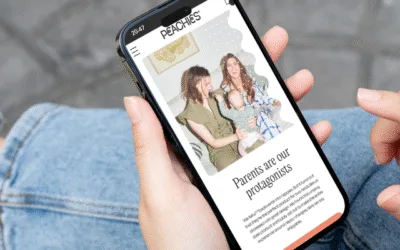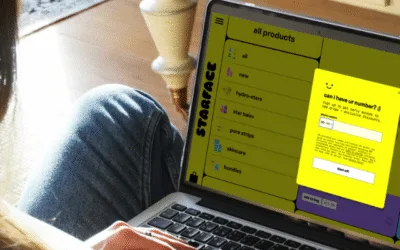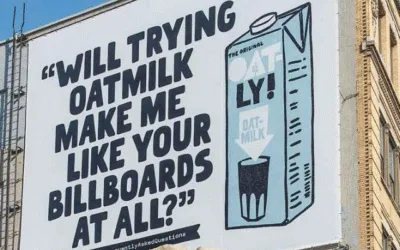Peachies beat Pampers by selling sleep, not nappies. Learn their Ladder of Why messaging trick to make your copy resonate.
Get more repeat orders and fewer returns with this 5-min email fix.
You might be missing a massive opportunity to build brand loyalty and get more orders. Luckily there's an easy fix that takes a few minutes.
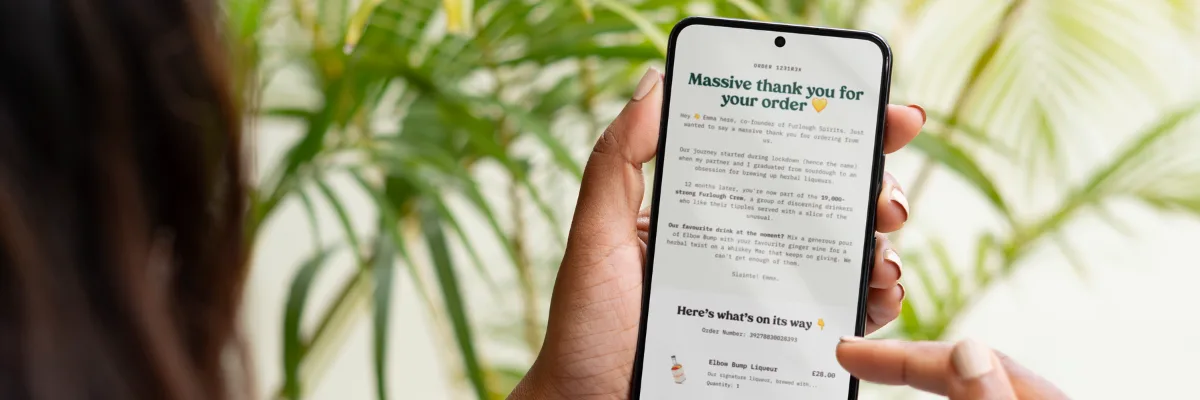
Get pro copy tips, branding tricks and e-comm insights directly to your inbox every Tuesday.
With the cost of ads going through the roof and every market feeling more crowded than ever before, we wanted to give you something that you can…
👉 Write in ten minutes flat (5 mins if you use the template at the end of this email)
👉 Whack in your post-purchase sequence
👉 Turn the customers you’ve already worked so hard to convert into customers that come back again and again.
So we’ve put together a 100ish-word snippet of copy you can add to your order confirmation email that will boost your customer retention, AOV and refund rate.
(Post-purchase wins are our favourite because they’re all upside baby.)
Let’s dig into it 👇
💡 Most order confirmation emails are just a fancy receipt. But you can use 100 or so words and some consumer psychology to turn them into retention levers.
Did you know that Klaviyo’s 2024 benchmark data shows that post-purchase emails earn 55% higher opens, nearly 4X clicks, and 380 % better conversion rates compared to standard campaigns?
And yet, most brands massively miss the opportunity to turn order confirmation emails into something bigger. (One study from a few years ago estimated that 1 in 3 post-purchase emails were written by technical/IT team members, not copywriters or anybody in marketing.)
In other words, we’re all sending emails that we know are going to get read 55% more than marketing emails.
That we know drive 380% more revenue than marketing campaigns.
And that we can write, set and forget and increase all future sales and customer retention.
But we’re not using them to their fullest potential.
And here’s why this is such a quick win: it’s the lowest hanging fruit to drive more sales, improve LTV and get your brand to the land of customer loyalty.
And you can do it in like 100 words or less with a clever combination of copywriting and consumer psychology.
Here it is 👇
100 words to take your order confirmation emails from box-ticking to loyalty winning.
July is a hectic month for the two of us. Between us, we have 9 birthdays to buy for. Which means that our inboxes are chock-a-block with order confirmation emails.
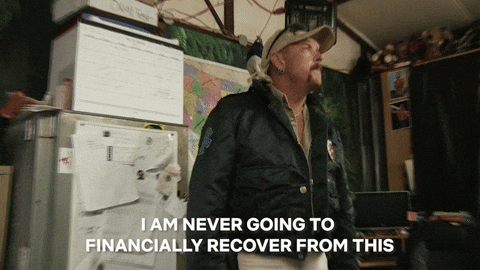
Almost every single order confirmation email we got ticked all of the boxes from a logistics point of view.
They all did the necessary stuff like confirmed our orders, gave us the tracking link, told us what happens next. And when we close those emails, we leave knowing that everything went to plan, when we’re going to get our deliveries and that we can tick that task off our list.
That alone is a win.
But when we know that upwards of 80% of people are going to read these emails, we can do more than just tick boxes.
There’s a moment right after the checkout high fades where your customer doesn’t just want facts and delivery details.
They want to feel smart, excited, and like “yes, I’m so bloody happy I just bought this”. They want reassurance that they didn’t just make a mistake or do something they’ll later regret.
(Especially in ecommerce where that immediate gratification you get when you shop IRL doesn’t exist.)
That’s a huge opportunity for your brand.
Because while we all have logistics questions we want answering after a purchase (when will this arrive? What did I order again?), we’re also all a bit messy.
As soon as we hit buy now, the ol’ buyer’s remorse kicks in and we’re thinking things like:
“Wait, did I really need this?”
“Who is this brand again?”
“Is this worth the wait?”
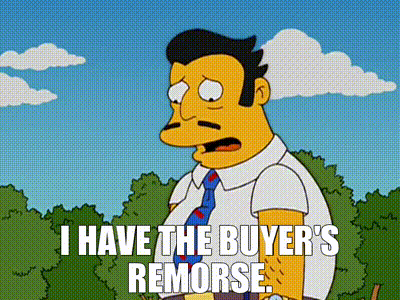
And if your email doesn’t answer those subtler, more empathetic questions, our brains start to fill in the gaps on their own. In fact, some studies estimate that 74% of us start to feel doubt over our decision as soon as we’ve hit that “buy now” button.
And studies building on that research show that regret is a straight‑line predictor of somebody hitting return or cancelling their order.
So, in very real terms, if your confirmation email only answers the logistics questions and ignores the human ones, you’re handing that anxious part of your customers’ brains a blank page that they usually fill with ‘Maybe I should cancel or return it when it arrives.”
However, if you flip these emails into something that’s more than just “You ordered the thing”. Something more like “You made the right call. Welcome to the club”, then you’re answering those doubts before they take root.
And even better, most brands we see don’t go that far.
Which means when you do, you stand out instantly.
But the best part? You can tick all those boxes in 100 or less words with a clever paragraph that ticks all the boxes.
And it goes a little something like this 👇
Massive thank you for your order
Hey 👋 Emma here, co-founder of Furlough Spirits. Massive thank you for your order. Our journey started during lockdown (hence the name) when my partner and I graduated from sourdough to an obsession for brewing up herbal liqueurs. 12 months later, you’re now part of the 19,000-strong Furlough Crew, a group of discerning drinkers who like their tipples served with a slice of the unusual. Our favourite drink at the moment? Mix a generous pour of Elbow Bump with your favourite ginger wine for a herbal twist on a Whiskey Mac that keeps on giving. We can’t get enough of them.
Slainte! Emma.
Those 101 words pack in so many clever little customer retention tricks it’s unreal.
👉 Expressing sincere gratitude to the customer
“Massive thank you for your order.”
Saying thank you to your customers might seem a bit obvious, but it’s a game-changer.
A Journal of Marketing found that:
“Customer gratitude fully mediates the effect of relationship‐marketing investments on both share of wallet, sales revenue, and sales growth … indicating that buyers who feel appreciated allocate a larger portion of their purchases, spend more overall, and increase their spending at higher rates over time.”
Basically, saying thank you (and meaning it) = more return customers and ever-increasing AOV. Not bad for 2 words!
👉 Tell your brand story
Our journey started during lockdown (hence the name) when my partner and I graduated from sourdough to an obsession for brewing up herbal liqueurs.
Notice the super-specific details of the story (sourdough, lockdown)? They help with something that researchers call narrative transportation, which is where the customers’ brains start to picture your story as they read it and align themselves with your brand. And, as a result, remember you much better.
Plus, telling a brand story can raise perceived value of your product by 2,706 %making your customers more likely to feel like they got a bargain than to feel buyers’ remorse.
👋 Bonus tip: if your brand or product has a clever name or a personal relevance or something that makes people say “aha! I get it!”, this is a great place for it.
We’re sending an email on this in a few weeks, but it’s called The Generation Effect. And it says that we remember information far better when we figure it out for ourselves or get that “aha! moment” of realising what something means.
The classic example of this is Slamecka & Graf’s 1978 study that showed people have up to 2× better recall for words they had to complete themselves (“H _ R S E → HORSE”) versus words they merely read.
More recently, we’ve seen challenger brands like Seep use it to great effect on their website 👇
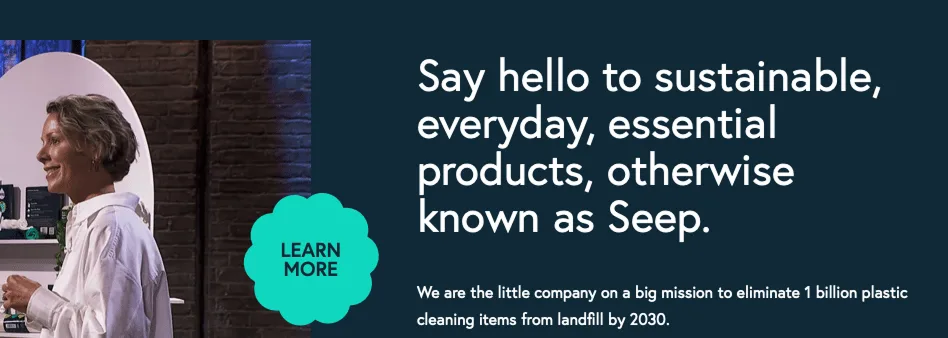
👉 Create a sense of belonging and social proof
12 months later, you’re now part of the 19,000-strong Furlough Crew, a group of discerning drinkers who like their tipples served with a slice of the unusual.
Now we’re getting into Social Identity Theory (AKA, making the customer feel like you’re the brand for them), so there’s lots of things happening here.
- We’re creating an emotional connection. We’re not just saying “people who enjoy herbal drinks”, we’re going deeper to make it a statement about who they are as a person. This makes the customers feel seen, and Harvard’s research shows that customers that feel seen and connected with a brand are 52% more valuable over time than those who are merely “satisfied.” AKA, they come back more often, spend more per order, and actively advocate for your brand.
- We’re also using the Bandwagon Effect (19,000 people) to reenforce the purchasing decision they just made and reduce buyer’s remorse.
- We’re also using Reference Group Effect by showing that people just like them are fans of the brand too. In other words, the copy is saying “Other people you’d probably like and trust made this exact choice, so you can trust it.” Again, nipping the doubt in the bud before it flowers.
- There’s a sprinkling of Optimal Distinctiveness Theory too (remember that from a few weeks ago?) with that “discerning drinkers who like their tipples with a slice of weird” line. It’s not just a shared interest (herbal liqueurs), it’s a shared point of view, which is way more powerful.
Now, that makes it all sound more a lot more complicated than it actually is. As a rule of thumb, as long as you’re creating a sense of community that’s around shared ideals and values rather than interests in common, you’re absolutely golden. (We’ve written more about that here.)
👉 Create a sensory first-use tip
Pro tip: Mix a generous pour of with your favourite ginger wine for a twist on a Whiskey Mac that keeps on giving. I can’t get enough of them.
You’ve already thanked them, told them who they are, and made them feel part of something. The last step is making them picture using your product for the first time.
This is a technique known as future pacing, and it basically means getting your customer to mentally rehearse or imagine what it’ll be like to use (and love) your product.
And it works. Studies show that when people can vividly picture using something, they’re significantly more likely to follow through, enjoy it, and keep it.
And the best part? It doesn’t have to be a long description. One quick tip with a quick sensory detail (“generous pour”) and a desirable outcome (“herbal twist on a Whiskey Mac that keeps on giving”) and you’ve moved your customers from “I hope I like this” to “I can’t wait for that first sip.”
☝️ And there you have it.
100-ish words and you’ve taken customers from knowing when their order is going to be delivered to eagerly waiting for it to land on their doorstep. Not bad!
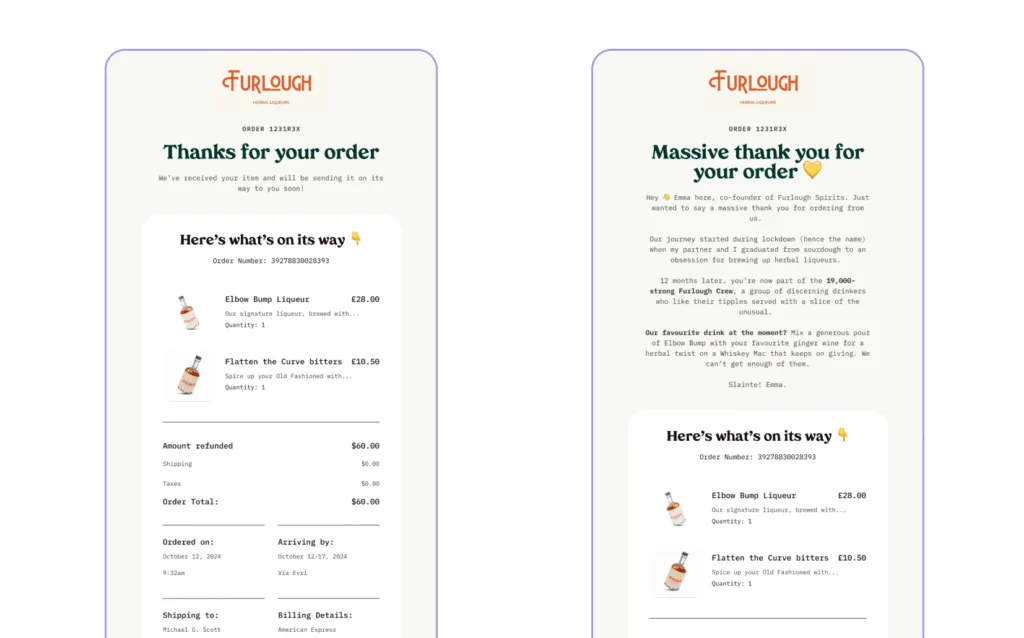
Copy, edit and paste this into your post-purchase email 👇
A massive thank you from us [optional: on-brand emoji]
Hey 👋 [Founder Name] here, [title] of [Brand Name]. Massive thank you for your order. Our journey started [timeframe or moment] when [short, vivid backstory—where the idea came from]. Now you’re part of the [community name + size], a group of [who your customers are / what they stand for]. Pro tip: [1-sentence tip to help them use, enjoy, or serve your product].
[Signature sign-off phrase],
[Your Name]
Write that in your brand voice, add some details from your brand story (go back to last week’s email if you need a hand there) and you’re cooking!
In less than 10 minutes, you’ve got something that’s ready to drop into your Klaviyo flow or Shopify emails that’s going to cut refunds, shrink WISMO tickets, and massively boost the chances your customers remember you and come back for a second order.
All from 110 words. Not bad, eh?
See you next week for more ways to do words gooder.
Dive into more free tips and tricks 👇
How Starface use orthography to build a killer brand voice their customers love
The words you write matter. But so do your full stops, emojis and lowercase letters. Learn how to turn punctuation into a powerful part of your brand voice.
Why Oatly’s brand voice is so damn good (and how yours can be, too)
We dig into the three layers of brand voice (10,000ft, 1,000ft, ground level), show how Oatly nails each one and how you can do it for your own brand.
The weekly newsletter that takes your brand’s copy from “meh” to “hell f*cking yeah!”
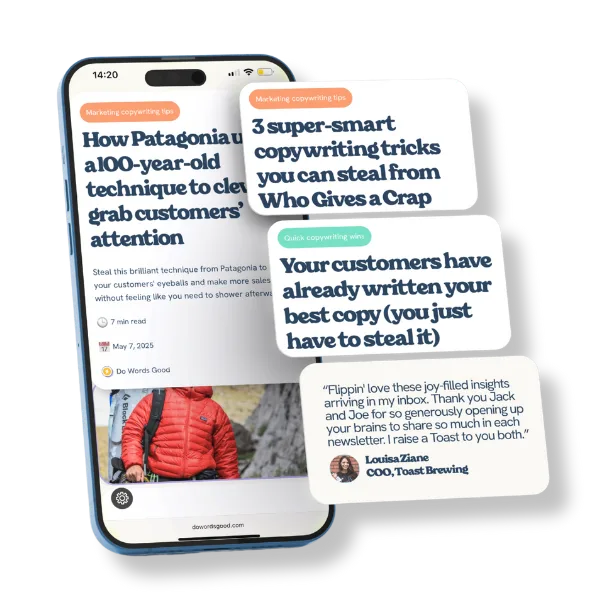
Read every week by legends at brands like these











